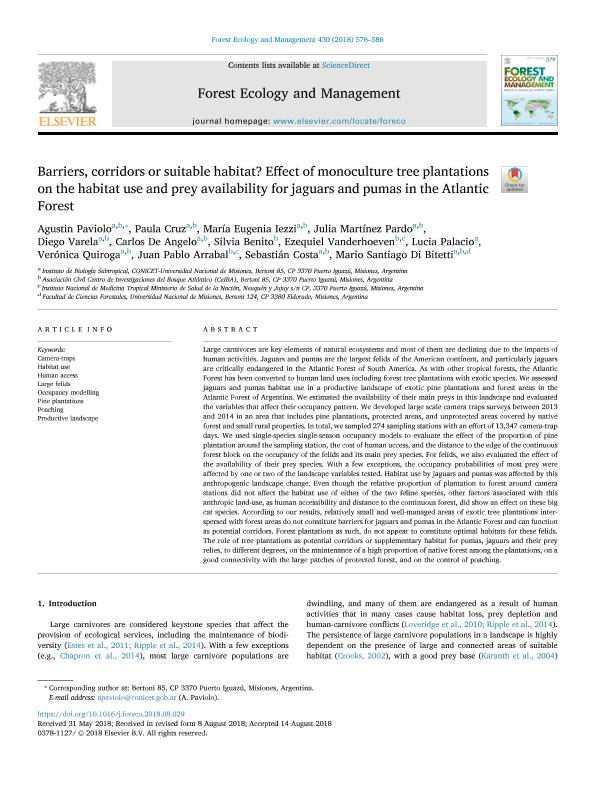Artículo
Barriers, corridors or suitable habitat? Effect of monoculture tree plantations on the habitat use and prey availability for jaguars and pumas in the Atlantic Forest
Paviolo, Agustin Javier ; Cruz, María Paula
; Cruz, María Paula ; Iezzi, María Eugenia
; Iezzi, María Eugenia ; Martínez Pardo, Julia
; Martínez Pardo, Julia ; Varela, Diego Martin
; Varela, Diego Martin ; de Angelo, Carlos Daniel
; de Angelo, Carlos Daniel ; Benito, Silvia; Vanderhoeven, Ezequiel Andres
; Benito, Silvia; Vanderhoeven, Ezequiel Andres ; Palacio, Lucía Andrea
; Palacio, Lucía Andrea ; Quiroga, Verónica Andrea
; Quiroga, Verónica Andrea ; Arrabal, Juan Pablo; Costa, Sebastián Andrés
; Arrabal, Juan Pablo; Costa, Sebastián Andrés ; Di Bitetti, Mario Santiago
; Di Bitetti, Mario Santiago
 ; Cruz, María Paula
; Cruz, María Paula ; Iezzi, María Eugenia
; Iezzi, María Eugenia ; Martínez Pardo, Julia
; Martínez Pardo, Julia ; Varela, Diego Martin
; Varela, Diego Martin ; de Angelo, Carlos Daniel
; de Angelo, Carlos Daniel ; Benito, Silvia; Vanderhoeven, Ezequiel Andres
; Benito, Silvia; Vanderhoeven, Ezequiel Andres ; Palacio, Lucía Andrea
; Palacio, Lucía Andrea ; Quiroga, Verónica Andrea
; Quiroga, Verónica Andrea ; Arrabal, Juan Pablo; Costa, Sebastián Andrés
; Arrabal, Juan Pablo; Costa, Sebastián Andrés ; Di Bitetti, Mario Santiago
; Di Bitetti, Mario Santiago
Fecha de publicación:
12/2018
Editorial:
Elsevier Science
Revista:
Forest Ecology and Management
ISSN:
0378-1127
e-ISSN:
0378-1127
Idioma:
Inglés
Tipo de recurso:
Artículo publicado
Clasificación temática:
Resumen
Large carnivores are key elements of natural ecosystems and most of them are declining due to the impacts of human activities. Jaguars and pumas are the largest felids of the American continent, and particularly jaguars are critically endangered in the Atlantic Forest of South America. As with other tropical forests, the Atlantic Forest has been converted to human land uses including forest tree plantations with exotic species. We assessed jaguars and pumas habitat use in a productive landscape of exotic pine plantations and forest areas in the Atlantic Forest of Argentina. We estimated the availability of their main preys in this landscape and evaluated the variables that affect their occupancy pattern. We developed large scale camera traps surveys between 2013 and 2014 in an area that includes pine plantations, protected areas, and unprotected areas covered by native forest and small rural properties. In total, we sampled 274 sampling stations with an effort of 13,347 camera-trap days. We used single-species single-season occupancy models to evaluate the effect of the proportion of pine plantation around the sampling station, the cost of human access, and the distance to the edge of the continuous forest block on the occupancy of the felids and its main prey species. For felids, we also evaluated the effect of the availability of their prey species. With a few exceptions, the occupancy probabilities of most prey were affected by one or two of the landscape variables tested. Habitat use by jaguars and pumas was affected by this anthropogenic landscape change. Even though the relative proportion of plantation to forest around camera stations did not affect the habitat use of either of the two feline species, other factors associated with this anthropic land-use, as human accessibility and distance to the continuous forest, did show an effect on these big cat species. According to our results, relatively small and well-managed areas of exotic tree plantations interspersed with forest areas do not constitute barriers for jaguars and pumas in the Atlantic Forest and can function as potential corridors. Forest plantations as such, do not appear to constitute optimal habitats for these felids. The role of tree plantations as potential corridors or supplementary habitat for pumas, jaguars and their prey relies, to different degrees, on the maintenance of a high proportion of native forest among the plantations, on a good connectivity with the large patches of protected forest, and on the control of poaching.
Archivos asociados
Licencia
Identificadores
Colecciones
Articulos(CCT - NORDESTE)
Articulos de CTRO.CIENTIFICO TECNOL.CONICET - NORDESTE
Articulos de CTRO.CIENTIFICO TECNOL.CONICET - NORDESTE
Articulos(IBS)
Articulos de INSTITUTO DE BIOLOGIA SUBTROPICAL
Articulos de INSTITUTO DE BIOLOGIA SUBTROPICAL
Articulos(IDEA)
Articulos de INSTITUTO DE DIVERSIDAD Y ECOLOGIA ANIMAL
Articulos de INSTITUTO DE DIVERSIDAD Y ECOLOGIA ANIMAL
Citación
Paviolo, Agustin Javier; Cruz, María Paula; Iezzi, María Eugenia; Martínez Pardo, Julia; Varela, Diego Martin; et al.; Barriers, corridors or suitable habitat? Effect of monoculture tree plantations on the habitat use and prey availability for jaguars and pumas in the Atlantic Forest; Elsevier Science; Forest Ecology and Management; 430; 12-2018; 576-586
Compartir
Altmétricas



